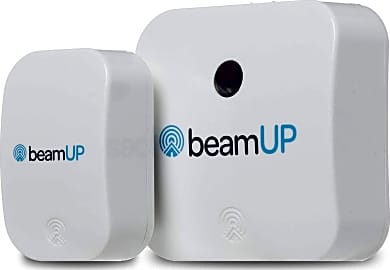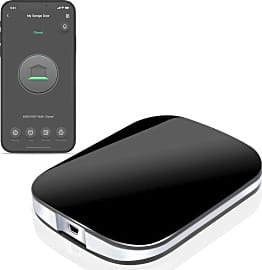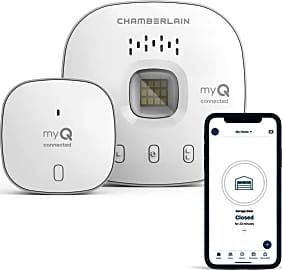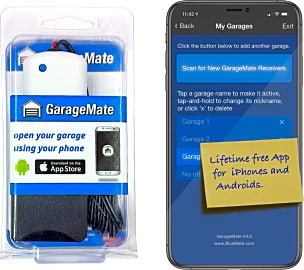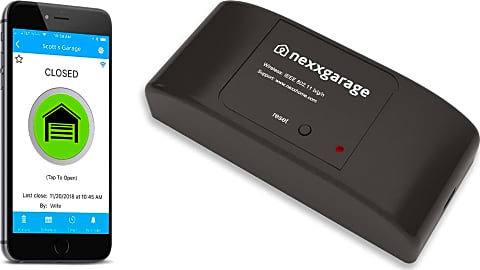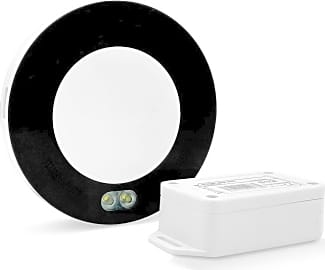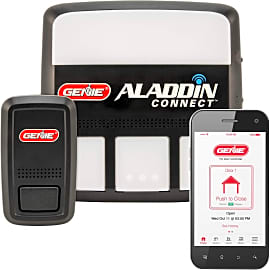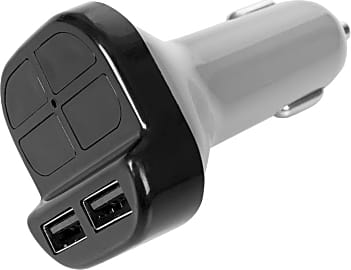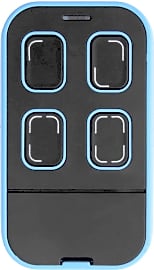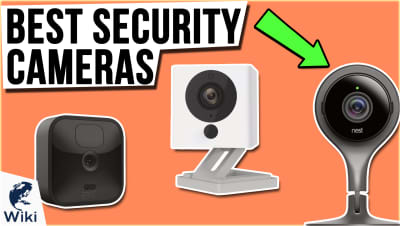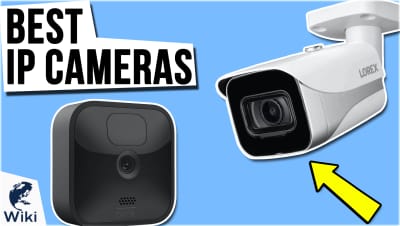The 10 Best Garage Door Remote Controls

This wiki has been updated 43 times since it was first published in March of 2015. Whether you're out jogging, riding a bike, or driving home after a long day at work, you can ensure your safety and convenience when approaching your house with one of these garage door remote controls. Our selections for this category include some highly advanced models that offer app connectivity and features such as video surveillance, scheduled events and smart-home integration. When users buy our independently chosen editorial choices, we may earn commissions to help fund the Wiki.
Editor's Notes
April 14, 2021:
After undergoing a total overhaul last year, this list held up pretty well for the last little while, and we didn’t find that a lot of changes needed to be made during this round of updates. The only real substantive modification we made was replacing the Chamberlain myQ-G0301 with the Chamberlain myQ-G040 – an updated model that’s been reviewing extremely well and offers better compatibility than its predecessor, as well as a redesigned, all-white housing that looks more modern than the myQ-G0301.
There’s no doubt that a solid garage door opener can offer you peace of mind and help keep your premises secure, especially if it has Wi-Fi connectivity, but to make the most of it you’ll likely want to keep eyes on your garage at all times, as well. Models like the Alcidae Garager 2 AG-02 come with a surveillance camera, but if you’re considering another model that doesn’t, then you might also be interested in our list of security cameras.
April 01, 2020:
With all the advances in smart-home technology over the past few years, there was just no comparing our previous picks for this category with some of the options available today. Thus, we made a clean sweep of these rankings, from top to bottom, and replaced all of our selections with newer, more-sophisticated models. Although we did include a couple basic, universal options – like the Xihada 12-Volt, which is powered by the DC outlet in your car and has two convenient built-in USB ports – most of our new choices are smart options that allow you to tether your smartphone to your garage door, so you can have one less thing to worry about. Some models, like the Nexx Garage NXG-100B, can even employ geofencing technology to open the door as you’re approaching your house, without you ever needing to lift a finger.
A few things to look for in this category:
Smart-Home Integration: While most of our selections are centered on connecting your smartphone to an existing opener, the Xihada Universal and Xihada 12-Volt are basic models that can clone the signal from your existing remote, allowing you an extra unit for your partner or children. Beyond that, most selections have some smart-home compatibility, though not all are compatible with all systems. The Chamberlain MYQ-G0301 is one of the few offerings that connects with Wink systems, and while many models can connect with Amazon Alexa, the iSmartGate Pro 02WNA102 can only do so through IFTTT – which can be a hassle.
Video Surveillance: Many models can let you know in real time whether your garage door is open or closed, but some go a step further by incorporating video surveillance to give you added peace of mind. The iSmartGate Pro 02WNA102 can be hooked up to any internet protocol camera, and the Alcidae Garager 2 AG-02 has a built-in camera with a 127-degree wide-angle lens and 1080p night vision.
App Functionality: As previously mentioned, all of our selections – apart from the Xihadas – connect to some sort of smartphone app, but these apps don’t all have the same features, so take a look and compare to make sure you’re not missing out on any conveniences that you might enjoy. The GarageMate GM2540-W has the option to implement a useful desktop widget, while the Nexx Garage NXG-100B can issue voice notifications anytime somebody opens or closes your door, and the Alcidae Garager 2 AG-02 even lets you communicate with anybody inside your garage via intercom – using its integrated microphone and speaker.
Special Honors
Tailwing iQ3 This feature-packed model uses Bluetooth and a vehicle sensor to recognize when you're rolling up the driveway, and it's compatible with most smart-home systems – but not Apple HomeKit. Its app can accommodate unlimited users, and it's a fairly straight-forward DIY model – though it's been noted that its instructions could be more thorough. gotailwind.com
Open Sesame App If you, or some of your family members, continually lose your garage door remote controls, then a simple solution might be an app like this one, which comes with a small Bluetooth module that transforms virtually any smartphone into an opener. It doesn't offer all of the conveniences that come with Wi-Fi connectivity, but its price is also hard to argue with, and you can pair as many phones as you want. mygarageopener.com
Open Sesame
This process usually occurs instantly when you depress the button on your remote control and aim it at the door.
Imagine that it's late at night in the middle of winter and you're on your way home. The last thing you want to have to think about is manually lifting your garage door to get your car inside. You want the convenience of a remote control to send a signal to your door's motorized opening mechanism to lift the door for you. So how does this little device work, you ask? How does it know to only open your garage door and not your neighbor's? Furthermore, how can you be confident that a criminal can't obtain your remote's transmission code by simply recording its signal and playing it back to gain unlawful access to your home?
A garage door remote control transmitter allows for a physical point-and-click system between you and the door itself. Simply aim the transmitter at your door and it opens. Modern garage door transmitters leverage what's called rolling code (also referred to as hopping code) for extra security. Use of rolling code prevents a criminal from recording the signal transmission and playing it back to the door's receiver when you aren't there.
Remote controls can send signals using rolling code, fixed code, or a combination of the two. Rolling code is different with each signal transmission to the receiver. By contrast, a remote using fixed code will always send the same code to the receiver, regardless of how many times the remote's button is pushed. Using rolling code with a garage door remote significantly increases security and the degree of difficulty for a criminal to cause mischief, since it is always changing and tough to pinpoint. Think of rolling code as a lightning storm. If you could control the lightning and pinpoint the exact location it would strike land, you would be operating as the transmitter, while the lightning bolt would be the code used to make the connection to the receiver (the land) for striking. Obviously, a garage door receiver doesn't get fried when it receives the correct code from its remote transmitter, so converting your garage receiver into a lightning rod wouldn't be recommended.
Rolling code remotes use encrypted radio frequency (RF) transmissions to communicate with your garage door's motorized opening mechanism (the receiver). The RF transmission is usually made up of a combination of fixed and rolling code. The receiver first separates the fixed code from the rolling code, then determines that the signal has originated from an authorized transmitter (your remote), and finally generates a signal to activate its electric motor to either raise or lower the garage door. This process usually occurs instantly when you depress the button on your remote control and aim it at the door.
A Brief History Of The Garage Door Remote
The earliest transistorized garage door remotes from the 1950s were invented by engineer Richard Goldstein, who had a fascination with radio waves and built tube radios from scratch. The early remotes could easily clip onto a car's sun visor (and they still do today) and operated using a simple transmitter and receiver. This technology has its roots in World War Two when it was used to detonate remote bombs. Transmitters used a designated radio frequency, which the receivers would listen to and open or close the garage door depending on its position. The problem with this simplicity was that only a single signal was sent out from the transmitter, meaning that anyone with a transmitter could just drive down the street and open almost any garage door because they all operated on the same frequency.
By the 1970's, the technology became slightly more evolved with the use of the DIP switch, which was composed of eight small switches soldered to a circuit board.
By the 1970's, the technology became slightly more evolved with the use of the DIP switch, which was composed of eight small switches soldered to a circuit board. The DIP switch offered multicode use by allowing the user to set the DIP switches inside the transmitter in order to control the code that was sent. With this second stage wireless remote system, a garage door would only open if the transmitter's DIP switch was set to the same pattern as the DIP switch in the receiver. However, even DIP switches didn't provide a high enough level of security.
An intermediate system was released that was backwards compatible with the DIP switch and used remotes preprogrammed with over three billion possible codes, making them difficult to duplicate.
The third and fourth stages of remote systems make use of the rolling code technology that is still in use today. The fourth stage is limited to the 315 MHz frequency, which avoids interference from the Land Mobile Radio System (LMRS) used by the military.
Knowing Your Options
Security is a top concern when investing in a remote control. Anything that allows you to confirm your door is closed (and remains closed) is a welcome luxury. For that reason, many remotes offer the ability to monitor your garage door from a smartphone.
If you have more than one garage door, then a remote with separately dedicated buttons and frequencies is a convenient option so you don't have to keep multiple remotes in your car. On that same note, ease of programmability of such a remote is another big selling point, since you don't want to experience confusion or frustration trying to sync up the remote frequencies with the right door. Check out the instruction manuals for the remotes you're interested in. Finally, a thin remote will save extra space and clip easily to your car's sun visor.


